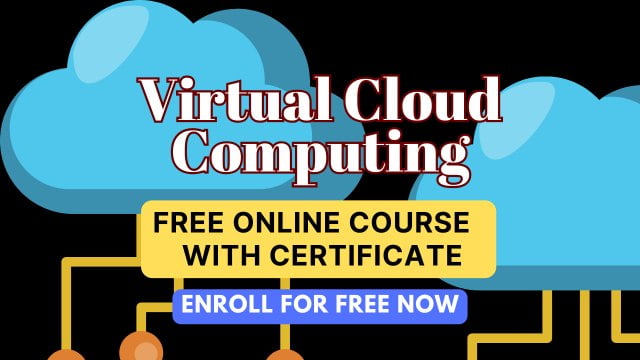
Virtual Cloud Computing Free Online Course
Virtual Cloud Computing Free Online Course
Virtual Cloud Computing: Unlocking the Potential of the Digital Horizon
In the fast-paced world of technology, the demand for flexible and scalable IT resources has become paramount. Businesses, large and small, are seeking solutions that can adapt to their evolving needs. Enter cloud computing – a revolutionary concept that has transformed the way we manage and access data and applications. In this course, we will delve into the need for cloud computing, introduce its fundamentals, explain its mechanics, and shed light on the crucial role of virtualization.
I. Introduction
A. Definition of Cloud Computing
Cloud computing is a paradigm that allows users to access and use IT resources, such as servers, storage, and applications, over the Internet. It eliminates the need for physical infrastructure, offering a more flexible and cost-effective solution. Virtual Cloud Computing Free Online Course
B. Importance of Cloud Computing
The significance of cloud computing lies in its ability to provide on-demand resources, enabling businesses to scale up or down based on their requirements. It fosters innovation, agility, and collaboration, driving digital transformation across industries. Virtual Cloud Computing Free Online Course
C. Overview of the Course
Our journey begins with a comprehensive understanding of cloud computing, starting with the different cloud models – public, private, and hybrid. We’ll explore various cloud services and highlight the advantages of flexibility and scalability that businesses can achieve. Virtual Cloud Computing Free Online Course
II. Understanding Cloud Computing
A. Cloud Models (Public, Private, Hybrid)
Each cloud model serves specific purposes. Public clouds offer shared resources, private clouds provide dedicated infrastructure, and hybrid clouds combine both for a tailored approach. We’ll explore when each model is most suitable. Virtual Cloud Computing Free Online Course
B. Cloud Services
From Infrastructure as a Service (IaaS) to Platform as a Service (PaaS) and Software as a Service (SaaS), cloud services cater to diverse needs. Understanding these services is crucial for making informed decisions in a cloud environment. Virtual Cloud Computing Free Online Course
C. Flexibility and Scalability
One of the primary benefits of cloud computing is the ability to scale resources as needed. We’ll delve into how businesses can dynamically adjust their IT infrastructure to meet changing demands, optimizing efficiency and costs. Virtual Cloud Computing Free Online Course
III. Virtualization Essentials
A. Introduction to Virtualization
Virtualization is the cornerstone of cloud computing. It involves creating virtual versions of computing resources, allowing multiple operating systems to run on a single physical server. This section will demystify the concept of virtualization. Virtual Cloud Computing Free Online Course
B. Role of Virtualization in Cloud Computing
Virtualization plays a vital role in enabling the agility and resource efficiency of cloud environments. We’ll discuss how it forms the backbone of cloud infrastructure, facilitating the delivery of services and applications. Virtual Cloud Computing Free Online Course
C. Key Virtualization Terms (Hypervisor, VMs, Containers)
To truly grasp virtualization, we need to understand key terms like hypervisor, virtual machines (VMs), and containers. This section will provide clarity on these concepts, breaking down their roles in the virtualization landscape. Virtual Cloud Computing Free Online Course
IV. The Course: Virtual Cloud Computing
A. Characteristics and Benefits of Virtualization
Our course focuses on the characteristics and benefits of virtualization. You will discover how it facilitates effective IT infrastructure management, increases flexibility, and optimises resource utilisation.
B. Optimization of Resource Utilization
Because virtualization runs multiple virtual machines on a single physical server, it improves the utilisation of hardware resources. This results in cost savings and increased efficiency.
C. Enhanced Flexibility
Discover how virtual cloud computing provides businesses with the flexibility to adapt to changing demands. Whether it’s scaling up during peak times or downsizing during lulls, virtualization ensures optimal resource allocation.
D. Efficient IT Infrastructure Management
The course will delve into how virtualization simplifies IT infrastructure management. Learn how it streamlines processes, reduces complexity, and enhances overall system performance.
E. Cost Savings, Disaster Recovery, and Business Continuity
We’ll explore the economic advantages of virtual cloud computing, including cost savings through resource optimization. Additionally, understand how virtualization contributes to robust disaster recovery and business continuity plans.
V. Significance in the Digital Landscape
A. Digital Transformation
Virtual cloud computing is at the forefront of digital transformation. Learn how businesses leveraging virtualization gain a competitive edge by adapting quickly to technological advancements and market changes.
B. Business Advantages of Virtual Cloud Computing
Explore the tangible business advantages that arise from adopting virtual cloud computing. From increased efficiency to enhanced innovation, businesses stand to gain significantly in the digital era.
VI. Conclusion
A. Summary of Key Points
In conclusion, virtual cloud computing is not just a technological trend but a necessity for businesses aiming to thrive in the digital landscape. This course equips you with the knowledge to harness the power of virtualization for your organization’s benefit.
B. Encouragement to Explore Virtual Cloud Computing
As you embark on this learning journey, we encourage you to actively engage with the course material. Ask questions, participate in discussions, and apply your newfound knowledge to real-world scenarios.
C. Call to Action
Ready to unlock the potential of virtual cloud computing? Enroll in our course today and gain a competitive advantage in the evolving digital ecosystem.
VII. FAQs
A. What is the main focus of the course?
The main focus of the course is to provide a comprehensive understanding of virtual cloud computing, covering cloud models, services, and the essential role of virtualization.
B. How does virtualization contribute to cost savings?
Virtualization optimizes resource utilization, leading to cost savings by allowing multiple virtual machines to run on a single physical server.
C. Are there prerequisites for the Virtual Cloud Computing course?
No specific prerequisites are required. The course is designed to accommodate learners with varying levels of expertise in cloud computing.
D. Can businesses of all sizes benefit from cloud computing?
Yes, cloud computing offers benefits to businesses of all sizes. It provides scalable solutions that can be tailored to the unique needs of each organization.
E. How does the course address disaster recovery?
The course explores how virtual cloud computing contributes to robust disaster recovery plans, ensuring data resilience and business continuity.








